Sesame Street Song There It Is Again
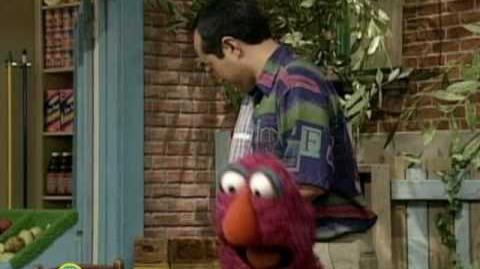
The Street Sings Sunny Days
(Episode 3952)
The Sesame Street Theme is the familiar opening theme song of Sesame Street. It is registered with ASCAP every bit "Tin You Tell Me How to Get to Sesame Street" with several alternating titles including "Sunny Twenty-four hour period".[one]
It is normally sung by The Kids. The theme introduces the magical globe of Sesame Street through its lyrics, stating that it is a place where "the air is sweetness" and filled with "friendly neighbors," and ofttimes asks the now-famous question "Can you tell me how to get to Sesame Street?"
In an unpublished memoir, Jon Stone commented that he personally had come up with many of the ideas for the song: "An integral part of [set designer] Charlie Rosen'south fix was a wall of doors...I wanted to employ these doors equally transition gateways from the reality of the street to our puppet or animation pieces. I told Bruce [Hart] to include 'Every door will open wide'", which was also meant as a reference to the phrase "Open Sesame," the inspiration for the show's title. "More important, I insisted that the recurring theme in the lyric be 'Tin you tell me how to get to Sesame Street?' The opening I envisioned was one of children...running happily, tumbling, playing along the way, but e'er intent on getting to Sesame Street..." Although Rock was pleased with Joe Raposo'south music, which he said was "melodic and uncomplicated enough for a child to recognize" and link with the show, he believed the last product was "a lyrical disaster," filled with "hackneyed phrases" and "astronaut slang" such every bit "A-OK" which he believed would "become obsolete."[2] Contrary to Stone's opinion, many of these "happy piffling clichés" (such as "Sunny day, sweepin' the clouds away") accept arguably become as inexorably linked to the series as the melody.
The song has been remade a number of times over the years, not but for the show's opening and closing credits, but also for inserts. Among the primeval, most distinctive versions of the theme characteristic solo harmonica performed by Toots Thielemans. William Galison provided the harmonica solo for the 30th Anniversary version of the theme (used from seasons 30 to 32).[3]
On The Muppet Prove, when the Sesame Street cast made a cameo in episode 518, the cast of both Sesame Street and The Muppet Show sang a verse of the theme song (this recording can be heard over a montage of Sesame Street clips in The Muppets: A Celebration of 30 Years).
Gladys Knight sang the theme in The Sesame Street Special. This recording was as well included in the anthology Sing: Songs of Joe Raposo.
A remix was recorded by Ursula 2000 for Songs from the Street: 35 Years of Music. This remix too featured sound clips from various Sesame Street albums. This recording sometimes accompanied montages in episodes of The Sesame Street Podcast.
Openings

Sesame Street Sunny Days Evidence Open Through the Years
A mashup of every Sesame Street main title, compiled and uploaded by SesameStreet's YouTube Aqueduct to mark the show's 50th anniversary.
The vocal has been a function of Sesame Street since the very beginning, equally information technology was used to open the offset pilot episode; this version is longer than that used in the serial proper. Sung by Bob McGrath, the rendition includes the complete lyrics, as heard on albums and elsewhere, but seldom included on the bear witness itself.
The more than familiar opening theme sung by a children'due south chorus, named Lois Winter and the Wee Willie Winter Singers,[iv] [five] was used from the show'south premiere in 1969 until 1992. Throughout this menses, the opening theme was accompanied by clips of children playing on location in a park or metropolis. Diverse sequences of footage were used and rotated from episode to episode. Big Bird was added to most versions of the sequence starting in flavor 4 and Barkley was added to the opening in season x; the actual rotation of openings, meanwhile, was replaced outright with new footage in both 1972 and 1988. Also, the rotation of openings during the first three seasons were shot on film, whereas the subsequent openings, beginning with season 4, were shot on camera, similar the street scenes and puppet segments.
For Flavor 24, the theme was updated with a calypso-flavored shell. The opening sequence employed the apply of numerous animated effects and featured many more Muppet characters, including Big Bird, Grover, Oscar the Grouch (running in his trash can), Cookie Monster, Count von Count, Prairie Dawn, Ernie, Bert, Elmo and Television set Monster. The opening footage was mostly standardized from episode to episode from this point on; however, an alternate version of the opening, introduced in Season 26[half dozen] and featuring Zoe and Baby Natasha in the places of Grover and Prairie Dawn, respectively, was occasionally shown. The opening sequence was designed past Balsmeyer & Everett, Inc.[half dozen]
In 1998, the opening reverted to footage of Large Bird and various children, with a rerecorded version of the theme resembling the original opening. The children vocals in this version are lifted straight from the theme song functioning recorded for The Official Sesame Street 2 Volume-and-Record Album. This lasted until 2002, when withal another opening sequence was produced featuring Large Bird and various children post-obit calculator-animated billowy blocks, with clips highlighting the main features of the show (Elmo'southward World, Monster Clubhouse, etc.). Near the end, Super Grover appears flying and crashing to the lesser of the "Sesame Street" lamppost. He gets back up, property a sign with the episode number written on it. The theme song was rerecorded in a rock style, and starting in Season 34, was remixed with flutes and harmonica. The opening was shortened on reruns, except for Season 37, the last season to use this opening.
For Seasons 38 and 39 (2007-2008), another new opening was used, featuring a slightly faster version of the theme with a minor hip-hop context to fit with the urban center setting. The sequence featured more Muppets, including Abby Cadabby, Oscar the Grouch, Elmo, Large Bird, Ernie, Bert, Cookie Monster, Super Grover, Zoe, Rosita, and a bird amidst a figurer-animated New York Urban center using "folding" furnishings (this format would likewise exist used for the segment transition bumpers and closing credits), and as well had the episode number appearing on a sign next to the "Sesame Street" sign on the distinctive lightpole. The graphics for this sequence were designed past Magnetic Dreams.
A new intro was created for Flavor 40 in 2009, featuring the Muppet characters in a chalk-drawn environment. Muppets who appear in this version of the opening include Large Bird, Oscar the Grouch, Elmo, Abby Cadabby, Ernie, Bert, Grover (and his super-hero alter ego), Cookie Monster, Zoe, Count von Count, Rosita, Idiot box Monster, Infant Bear, Murray Monster, Ovejita, Chickens, and Birds. After Super Grover knocks over the lamppost, it falls and the episode number is written side by side to it. The theme music is a remixed version of the 2007 theme, this time using mostly live instruments (i.e. acoustic drums, a horn section). This version was remixed again for Flavor 42.
For Season 46, when the serial began ambulation on HBO, another new opening sequence was introduced. For the outset time in the serial' history, the sequence takes place on the actual street set. It features a new folk arrangement and only consists of the first poesy.
Closings
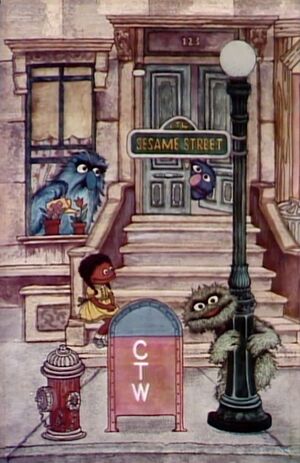
The illustrated closing from the early on '70s features various Muppets, including a rarely seen full body Oscar.
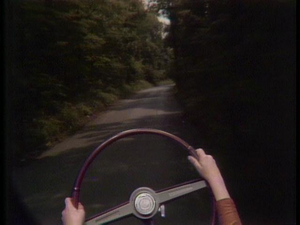
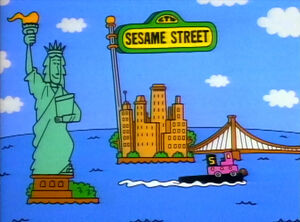
The 1992 closing, featuring vibrant, colorful animation by Joey Ahlbum.
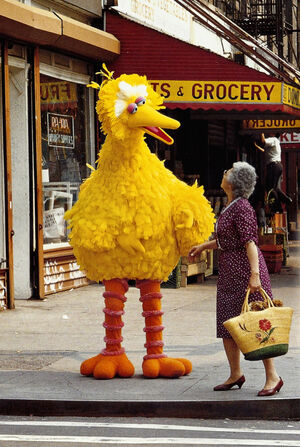
An instrumental version of the theme, featuring harmonica past Thielemans, regularly served as the outro for the starting time twenty three seasons of the evidence, and was only sporadically used afterwards. Like the opening, the closing has changed many times throughout the show'due south run. During the first flavour and for office of the 3rd, the credits (which until season 34 were by and large included merely on Fri episodes) rolled every bit the activeness from episodes connected on. The credits for season 2 featured still shots of children's paintings.
A quarter into Season three, the closing was changed to an illustrated sequence scrolling the length of a tall apartment edifice downwardly into 123 Sesame Street. Various Muppet characters were depicted in this endmost: Large Bird, Ernie, Bert, Cookie Monster, Oscar the Grouch, Kermit the Frog, Fiddling Bird, Herbert Birdsfoot, Lefty the Salesman, Roosevelt Franklin, Roosevelt Franklin's Mother, Herry Monster, Sherlock Hemlock, Professor Hastings, and numerous Anything Muppets. Grover appeared in various areas throughout this closing.
Tardily into the 5th season, the closing was changed to a live-activity drive through the countryside, with the commuter's hands over the steering bike beingness shown. This footage (without the added steering bicycle) was combined with films of railroad tracks and a canyon in the 1978-79 season. New live action footage of The Kids playing with Barkley was introduced in the 1980-81 flavor and remained in use for twelve years up to 1992. An alternate closing sequence, reusing footage from the song insert "Jogging" appeared in episodes 2095 and 2295.
An alternate closing with filmed sequences of New York City and upstate New York, recorded during the pre-dawn hours, was also occasionally used between seasons 18 and 23, ordinarily coinciding with episodes taking place at night. While this closing was oft accompanied with the standard harmonica theme, a lullaby version of the theme featuring a celesta accompanied the standard closings. During the late 1990s and early 2000s, a dissimilar arrangement was occasionally used to close out episodes taking place at night (This version originally included a children'southward chorus repeating "How To Go To Sesame Street?" which was later removed).
A new, primarily-animated closing sequence was produced in 1992 to coincide with the new opening introduced in the same twelvemonth, complete with an upbeat rearrangement of the theme. Similar the opening, this closing featured animated effects and appearances by Muppets — Elmo, Big Bird, and a dove — and diverse kids dancing. Unlike the 1992 opening sequence, this closing remained in use for fifteen years until 2007, making it the longest-running closing credit sequence used on the show; although it was progressively shortened beginning in 2001 (when references to "The Children's Television Workshop" were edited out) and in the next two seasons. Originally, the closing credits merely appeared in every fifth episode, merely starting in 1993, they would too appear for the flavor premiere. By 2003, the credits would be shown in every episode. This version of the closing theme was also used on NBC's broadcast of the Macy's Thanksgiving Solar day Parade whenever the Sesame Street float was introduced from 1995 to 2013.
During seasons 24 and 25, a more "one-time-fashioned" alternating credit crawl appeared exclusively on repeats from preceding seasons. This closing re-purposes footage from episode 2525 of Big Bird walking through Fundamental Park and downtown with a group of children. A remixed version of the classic endmost theme is used here, which had sporadically been used during seasons 22 and 23.
To coincide with the new opening sequence of 2007 and the "folding-city" bumpers used in between segments, a new endmost sequence was introduced in Season 38 with the camera panning around the CGI city, with appearances by Super Grover, Elmo, Big Bird and Abby Cadabby, accompanied by an urban-jazz instrumental version of the theme. It as well ends with a new Sesame Workshop logo instead of the animated one used since 2000 (Season 38 utilized an in-credit variant featuring Abby Cadabby, and Season 39 debuted a newly-blithe logo with an appearance past Elmo and other Sesame Workshop characters).
In 2009, a new credit sequence was created to go along with the new theme, and features Big Bird, Ernie, Bert, Cookie Monster, Abby, Zoe and Elmo dancing on and effectually the credits in a chalked background of each character. The closing music, like the opening, is remixed from the 2007 edition and was also re-recorded for season 42.
Thielemans' harmonic version of the closing theme was used for the anthology Sing-Along Travel Songs, accompanied with Elmo and Zoe providing the vocals. When it was released on The Best of Elmo anthology, only Elmo's vocal is heard.
For Flavour 46, when the series began airing on HBO, the closing theme was replaced with an original closing song "Smarter, Stronger, Kinder," every bit the credits play during the song. HBO edits of pre-2003 episodes also added the Friday credit sequences to Monday-Th episodes (for pre-flavor 24 episodes, these were usually taken from the Fridays of the week said episode originally aired).
Other appearances
As the show's theme song, information technology has been featured in many productions related to Sesame Street, in both vocal and instrumental class. An instrumental version with a flake of Christmas-sounding music was included at the outset of Christmas Eve on Sesame Street. Instrumental versions of the vocal also appeared in the first and last street scenes in Follow That Bird. The song, usually in instrumental form, has also been included in many video releases.
The theme is sampled in the score of The Not bad Muppet Caper during Oscar the Grouch's "very brief cameo." It also appears during the ending portions of "The Lovable Monsters of Sesame Street", and in Elmo Saves Christmas, it'due south incorporated into "Continue Christmas with You (All Through the Year)" and worked into the melancholy score for the future where Christmas takes identify every day and all the shops on Sesame Street accept airtight.
In most countries, several of the international Sesame Street co-productions use their ain theme song, while others use the original American version in their own style with slightly different lyrics; one instance being the Dutch co-production Sesamstraat (see Sesamstraat Thema).
As well, the Danish co-production Sesamgade uses the same theme (with the same audio from 2002), merely with a contradistinct text past Mariella Harpelunde Jensen, and so that information technology fits into a prove that focuses on Elmo.
The theme vocal was performed at the Jim Henson's Musical Earth concert on April xiv, 2012, and at A Swingin' Sesame Street Commemoration on October 25-26, 2019.
Sesame Street'southward 50th Ceremony Commemoration opens with a montage of the various opening intros used throughout the years. Shortly subsequently, a brief version of the song is sung by Joseph Gordon-Levitt and the cast.
Audio releases
All versions released are performed by The Kids, unless otherwise noted.
- The Sesame Street Book & Tape (1970)
- Sesame Street Theme/Howdy (single, 1970)
- Condom Duckie/Sesame Street Theme (single, 1970)
- The Official Sesame Street 2 Book-and-Record Album (1971)
- Sesame Street Alive! — performed by The Gang (1973)
- ¡Sesame Mucho! (1974) - Spanish version
- Sing the Hitting Songs of Sesame Street (1974)
- 60 Favorite Songs from Sesame Street (1975)
- 25 Greatest Hits (1975)
- Sesame Street Theme/Goin' for a Ride (single, 1976)
- Signs! (1977) — sung by Large Bird
- 10th Ceremony Album (1978)
- Sesame Street Treasury (1980)
- The Best of Sesame Street (1987)
- Bob'southward Favorite Street Songs (1991) — sung by Bob
- Sing: Songs of Joe Raposo (1992) - sung past Gladys Knight and The Pips
- Sesame Street Celebrates! (1994) — calypso version
- Platinum All-Time Favorites (1995)
- Sing-Forth Travel Songs (1996) — sung past Elmo and Zoe
- The Best of Elmo (1997) - sung by Elmo
- Sesame Street Best (1997)
- Songs from the Street: 35 Years of Music (2003) — both original album version and a remixed version
- Just Me! Music (2007) - sung past Elmo
- Elmo'southward Rainbow and Other Springtime Stories exclusive bonus CD (2010)
- Sunny Days Collection (2012)
- Summer Collection (2013)
- Due east is for Elmo! (2018) - sung past Elmo and Zoe
- All-Fourth dimension Favorites one (2018)
- Sesame Street Theme Vocal (2019 Mix)
- What's The Number? (2019)
- It's Time to Rock & Rhyme (2020) - sung by Elmo
References
The song has been referenced quite a few times on Sesame Street, or in related productions.
- A film insert showing kids playing with toys followed by adults working with similar objects includes a scene where a little girl plays the drums and sings a line of the theme song. (First: Episode 0796)
- In a late 1970s Reporter Kermit skit, Don Music wrote a similar song called "Yellowstone Park", and afterward he finished his vocal, Kermit asked him, "Incidentally, can you tell me how to go, how to get to Sesame Street?"
- In Episode 3699, Television receiver finishes making a temporary Sesame Street sign when a blue monster comes by and asks him how to get there.
- In Episode 3830, after The Amazing Mumford magically transports himself and Tv to Arizona, Telly asks an Anything Muppet cowpoke if she knows anything about how to go to Sesame Street.
- In Episode 5029, Elmo and Abby set the episode'south theme of maps with the help of a flower, who uses a map to notice out how to become to Sesame Street.
Publications
- The inside covers for Sesame Street Unpaved include sheet music and lyrics for this song.
- Sheet music was also published in The Sesame Street Vocal Book and The Sesame Street Songbook.
Sources
- ↑ Piece of work ID: 330176402
- ↑ Quoted in Street Gang: The Consummate History of Sesame Street by Michael Davis (New York: Viking Press, 2008), pp. 159-160.
- ↑ NPR interview
- ↑ Danny Epstein, quoted from Street Gang by Michael Davis, 2008, pp.161, New York: Viking Press
- ↑ TV Guide: fifty All-Fourth dimension Favorite Idiot box Themes liner notes
- ↑ 6.0 6.1 Rhea, Marji. "Post Effects for Cars, Spaceships, Muppets.." American Cinematographer, vol. 76, no. 5, May 1995.
elsberryprepertion63.blogspot.com
Source: https://muppet.fandom.com/wiki/Sesame_Street_Theme
0 Response to "Sesame Street Song There It Is Again"
Postar um comentário